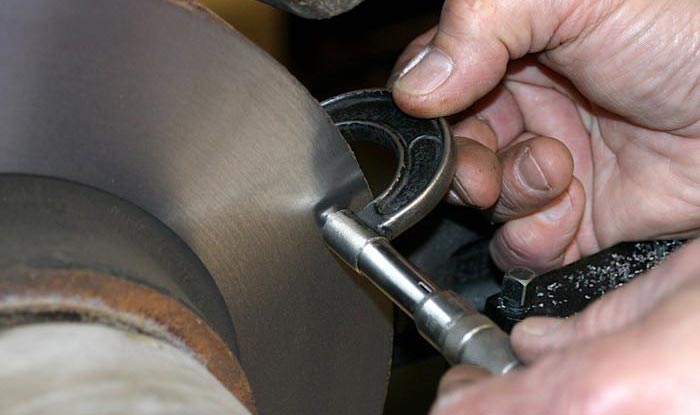Brake rotor measurements are determined by thickness, diameter, and runout. When inspecting brake rotors, these measurements are crucial to determine if the rotors are warped or damaged.
Proper maintenance of your vehicle’s brake system is critical for your safety. Brake rotors are one of the critical components of a vehicle’s braking system and require regular inspection and maintenance to ensure they are in good working condition. There are three essential measurements that you need to keep in mind when checking the rotors’ condition: thickness, diameter, and runout. The thickness of the rotor should be checked regularly to ensure it is within the manufacturer’s recommended range. Diameter and runout measurements are necessary to determine if the rotor is warped or damaged. Ensuring your brake rotors are in good condition helps prevent accidents and prolongs your vehicle’s lifespan.

Credit: www.tomorrowstechnician.com
What Are Brake Rotors?
Brake rotors are an essential component of a vehicle’s braking system. It is a disc-shaped metal part that sits between the brake pads. When the brake pedal is pressed, the brake pads squeeze the rotor, creating friction and slowing down the vehicle.
The rotor’s function is to dissipate the heat generated during this process. Over time, brake rotors can become worn or warped, increasing the stopping distance of the vehicle. It is essential to measure the brake rotor’s thickness and run-out to ensure they are within the manufacturer’s specifications.
Neglecting to measure and replace worn or warped brake rotors can result in reduced braking performance, decreased safety, and increased repair costs. Therefore, it is crucial to have brake rotors measured regularly to maintain optimal braking performance.
The Importance Of Brake Rotor Measurements
Brake rotor measurements play a vital role in ensuring safe and effective braking in your vehicle. Accurate measurements assure that the brake rotors are not worn or damaged. Even small changes in the size or shape of brake rotors can cause risks while driving.
If brake rotors are not replaced on time, they can damage other vital brake components. Worn or damaged brake rotors cause vibrations in the brake pedal, squealing noises or scratching sounds, and difficulty stopping. Ignoring these signs may lead to serious accidents.
It is important to measure brake rotors regularly and replace them when necessary to avoid risks associated with worn or damaged brake rotors. Don’t compromise on your safety and the safety of others while driving.
Brake Rotor Minimum Thickness Specification | Maintenance Minute
Measuring Brake Rotors
Measuring brake rotors is crucial to ensure your vehicle’s safety. The process requires a few tools, including a micrometer and a dial gauge. It’s important to be accurate and precise during the measurements to avoid any mishaps. Avoid common mistakes such as taking measurements on the worn surface or not accounting for the rotor’s thickness variation.
Remember that different rotors, brake pad materials and brake calipers require different measurements. Once you’ve mastered the measuring process, you can check the rotor’s thickness and compare it to the manufacturer’s recommendations to determine whether it needs to be replaced.
Make sure to take the time to measure your brake rotors to ensure your vehicle’s braking system stays in top shape.
Brake Rotor Measurement Standards
Brake rotor measurements have industry standards to ensure compliance with safety regulations. Understanding these standards is crucial in maintaining vehicle safety. To adhere to the guidelines, brake rotor dimensions, runout, and thickness must be periodically checked. Brake rotor compliance is imperative as non-compliance can decrease vehicle performance and endanger passengers.
Measuring brake rotors is essential in ensuring that vehicle braking works properly. Abiding by the industry’s brake rotor measurement standards is necessary in maintaining vehicle safety.
Interpreting Brake Rotor Measurements
Interpreting brake rotor measurements: it is essential to know when to replace your brake rotors. Reading measurements is one way to determine their status. However, it is not the only factor to consider. Other signs include vibration, noise, and reduced stopping power.
These indicators suggest that you should seek professional advice to know the best course of action. Professional mechanics are the best option as they will take into account other variables such as the type of vehicle, the type of brake pad, and the intended use of the vehicle.
With their guidance, you can make an informed decision about your brake rotor replacement, keeping you safe on the road. Remember, safety should always be a priority when driving.
Frequently Asked Questions For Brake Rotor Measurements
Conclusion
We have discussed the importance of understanding brake rotor measurements to ensure optimal performance of your vehicle’s braking system. Proper measurements ensure that you select the right rotor that fits your vehicle. You have learned about the different types of measurements, including diameter, thickness, and surface finish, as well as how to take accurate measurements.
It is crucial to take precise measurements to avoid unnecessary expenses and dangers that come with a faulty brake system. When buying new brake rotors, make sure they meet or exceed the specifications of the original equipment. Doing so assures compatibility, reduces vibration and noise, and enhances the brake system’s lifespan.
You should also stick to a routine maintenance schedule to ensure your braking system’s optimum performance. With these tips, you can confidently make informed decisions regarding brake rotor measurements, keeping your vehicle safe on the road.
Leave a Reply